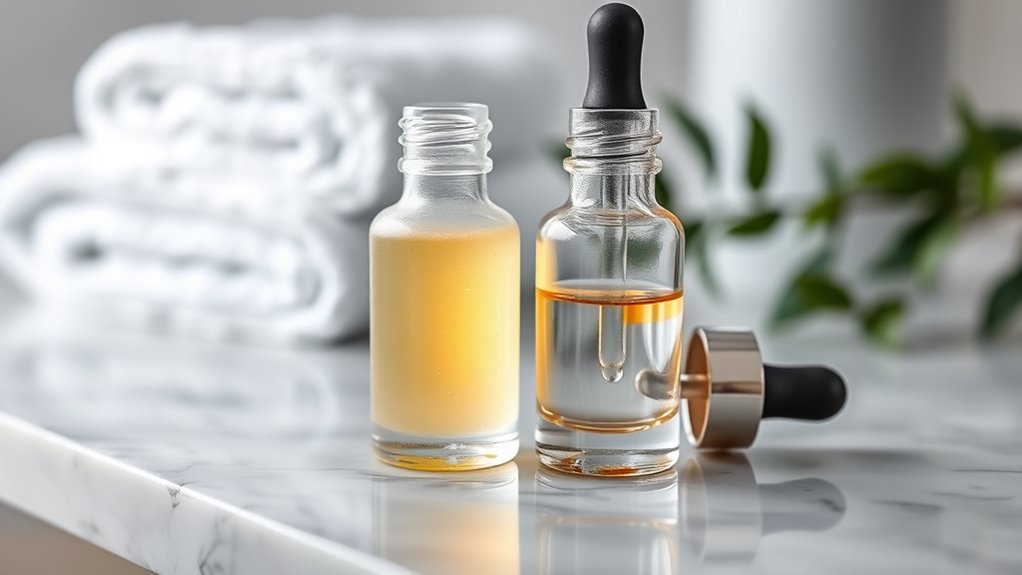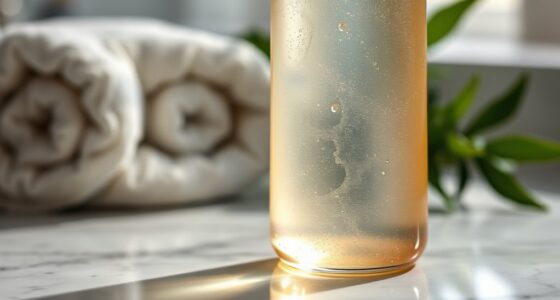Glycolic acid and salicylic acid each offer luxe exfoliation but serve different needs. Glycolic is great if you want brighter, smoother skin and fading dark spots, as it boosts cell turnover and collagen. Salicylic dives deep into pores, reducing oil and fighting acne for clearer skin. Knowing their unique benefits helps you choose the best for your skin goals. Keep exploring to discover how to use them safely and effectively for a radiant glow.
Key Takeaways
- Glycolic acid exfoliates surface dead skin cells, brightens, and stimulates collagen, ideal for dull, aging, or hyperpigmented skin.
- Salicylic acid penetrates deep into pores, unclogs sebum, and reduces inflammation, perfect for oily, acne-prone skin.
- Use glycolic for skin texture and radiance; salicylic for controlling oil and preventing breakouts.
- Combine both cautiously—alternate uses, low concentrations, and always protect with SPF.
- Proper patch testing and gradual introduction ensure safe, luxurious exfoliation tailored to your skin type.
Understanding the Basics of Glycolic and Salicylic Acids

Glycolic and salicylic acids are two popular ingredients in skincare, each offering unique benefits. Glycolic acid, an alpha hydroxy acid (AHA), is derived from sugarcane and is known for its powerful exfoliation properties. It works by removing dead skin cells from the surface, revealing brighter skin and improving skin texture. Salicylic acid, a beta hydroxy acid (BHA), comes from willow bark and excels at pore unclogging. Its oil-soluble nature allows it to penetrate deep into pores, making it especially effective for oily and acne-prone skin. Both acids provide distinct skin benefits—glycolic acid enhances radiance and collagen production, while salicylic acid targets congestion and breakouts. Understanding their basic functions helps you choose the right exfoliant for your skincare needs. Additionally, portable skincare tools can enhance the effectiveness of these acids during your skincare routine, offering convenient options for treatments on the go. Incorporating skincare technology can further optimize your exfoliation results and skin health. A thorough understanding of skincare ingredients can help you tailor your routine for optimal results and skin health.
How Glycolic Acid Works to Transform Your Skin

Because of its small molecular size, glycolic acid penetrates deeply into your skin, breaking apart the bonds that hold dead skin cells together. This exfoliation process reveals fresher, smoother skin underneath and accelerates cell turnover. As a result, your skin undergoes improved renewal, reducing dullness and promoting a more radiant complexion. Glycolic acid also stimulates collagen production, which helps diminish fine lines and enhances skin firmness and elasticity. Its ability to even out skin texture makes it effective against rough patches and uneven surfaces. Additionally, regular use can fade hyperpigmentation and dark spots, leading to a more uniform skin tone. Overall, glycolic acid transforms your skin by promoting deeper exfoliation, increased collagen, and a healthier, more luminous appearance. Incorporating exfoliation benefits into your skincare routine can further enhance your results and overall skin health. Furthermore, its capacity to improve skin texture fosters a smoother, more refined complexion over time. Enhanced skin renewal processes support ongoing skin rejuvenation, making glycolic acid a powerful ally in your skincare arsenal.
The Mechanism Behind Salicylic Acid’s Pore-Purifying Power
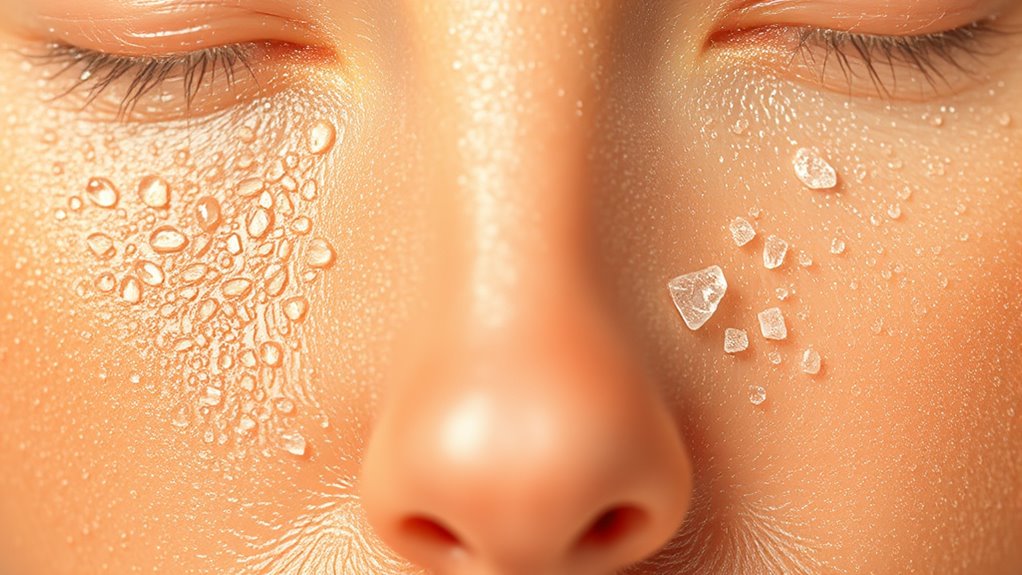
Salicylic acid’s lipophilic nature allows it to penetrate deeply into your pores, targeting excess oil and dirt. It also dissolves keratin bonds in dead skin cells, helping prevent clogged pores and breakouts. Plus, its anti-inflammatory properties calm redness and swelling, making it especially effective for inflamed skin.
Deep Oil Penetration
Salicylic acid’s unique ability to deeply penetrate pores relies on its lipophilic, or oil-attracting, structure. This trait allows it to target oily, congested skin effectively. Its small molecular size enhances pore penetration, reaching deep into clogged pores filled with sebum, debris, and dead skin cells. As an oil-soluble acid, it dissolves fats and oils, enabling sebum breakdown and clearing blockages from within. This makes salicylic acid an excellent chemical exfoliant for deep pore cleansing. Its anti-inflammatory properties further soothe irritated skin, reducing redness and swelling. Additionally, its penetration into skin layers helps deliver active ingredients more effectively, maximizing its cleansing benefits. Recognizing the importance of skin barrier integrity can optimize the efficacy of salicylic acid treatments and support overall skin health.
Anti-Inflammatory Action
The anti-inflammatory effects of salicylic acid are primarily driven by its ability to inhibit the production of pro-inflammatory mediators like prostaglandins. This action helps reduce redness, swelling, and skin irritation, especially for acne-prone skin. By targeting sebaceous glands, salicylic acid decreases sebum production and prevents clogged pores that lead to inflammation. Its lipophilic nature allows it to penetrate deeply into oily pores, delivering localized inflammation reduction. Additionally, salicylic acid diminishes the activity of enzymes involved in inflammation and inhibits leukocyte migration to inflamed areas. These combined effects promote skin calming and help prevent inflammatory acne lesions.
Key mechanisms include:
- Blocking pro-inflammatory mediators
- Deep pore penetration for targeted relief
- Reducing sebum and debris
- Limiting immune cell migration
Key Benefits and Ideal Uses for Glycolic Acid
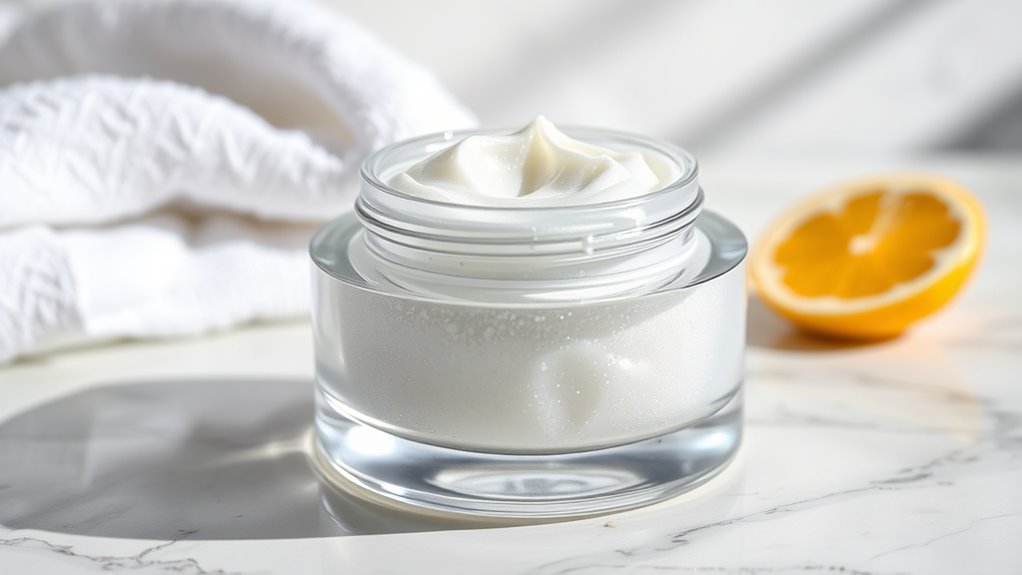
Glycolic acid offers a range of key benefits, making it a popular choice for those looking to enhance their skin’s appearance. As an effective exfoliant, glycolic acid penetrates deeply to promote cellular turnover, revealing smoother skin with improved texture. It’s especially beneficial for reducing dullness, hyperpigmentation, and fine lines, giving you a more radiant complexion. Its anti-aging properties help minimize superficial wrinkles, making it ideal for mature or sun-damaged skin. Typically used in serums and peels at concentrations around 5-10%, glycolic acid provides gentle yet effective exfoliation suitable for normal, dry, and combination skin types. Incorporating it into your skincare routine can boost skin radiance, smoothness, and overall youthful glow.
How Salicylic Acid Can Address Acne and Excess Oil

Because it penetrates deeply into pores, salicylic acid effectively dissolves excess sebum and debris, helping to unclog pores and prevent breakouts. Its pore-unclogging action reduces the likelihood of acne formation. Salicylic acid also offers anti-inflammatory benefits that lessen redness and swelling. Regular use promotes exfoliation, removing dead skin cells that can block pores. Its sebum regulation properties make it especially useful for oily skin. Additionally, its exfoliation capabilities can improve skin texture over time. An understanding of skin exfoliation can help optimize its benefits while minimizing irritation. Proper exfoliation techniques ensure effective results without overstripping the skin. Incorporating the right skincare routine can enhance its efficacy and safety. Here are four ways salicylic acid addresses acne and excess oil:
- Deep pore cleansing for clearer skin
- Reduces inflammation and redness
- Controls excess oil and shine
- Prevents future breakouts through exfoliation
Determining Which Acid Is Suitable for Your Skin Type
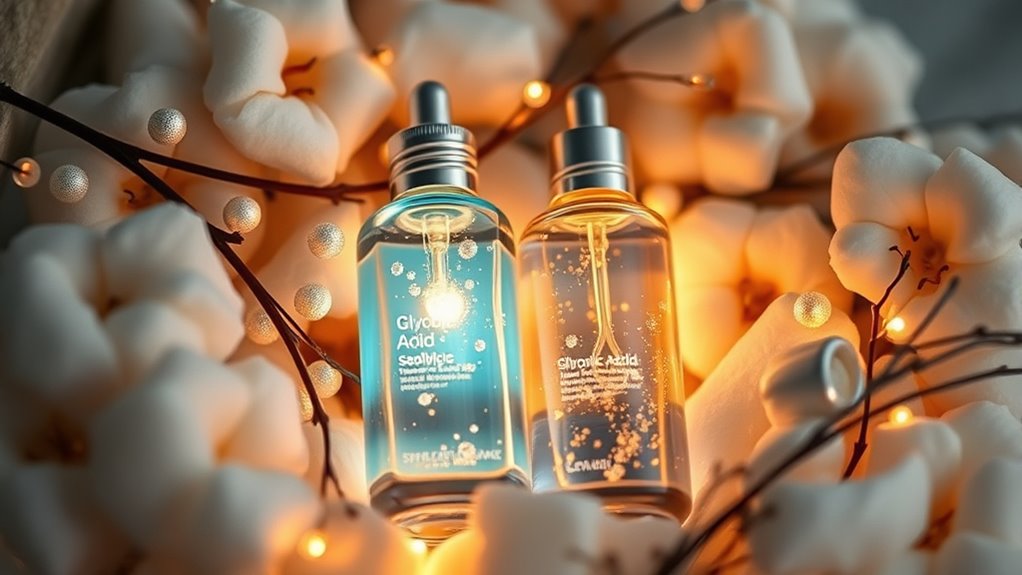
Choosing the right acid depends on your skin type and specific concerns. If you have oily skin or struggle with acne, salicylic acid is your best bet, as it penetrates deep into pores to unclog oil and reduce breakouts. For dry or sensitive skin, glycolic acid offers gentle exfoliation of dead surface cells without stripping moisture, making it suitable for sensitive skin. If you’re dealing with hyperpigmentation or signs of aging, glycolic acid’s collagen-boosting and brightening effects can help. Meanwhile, salicylic acid’s anti-inflammatory properties calm inflamed, red skin prone to cystic breakouts. Both acids are effective chemical exfoliants, but selecting the right one depends on your skin concerns and tolerance. Incorporating proper formulation into your skincare routine can enhance results and minimize irritation. Additionally, understanding Skin type compatibility and how these acids work can help you make more informed decisions. Using the correct acid for your skin type can also prevent potential irritation or damage. When choosing between glycolic and salicylic acid, consider their specific benefits to target your skin issues more effectively. Combining them can work for mixed skin but should be approached cautiously.
Potential Side Effects and Precautions for Safe Use

You need to be aware that both acids can cause skin irritation, redness, and dryness if not used properly. Applying them too often or at high concentrations increases the risk of sensitivity and damage. Always follow proper application techniques and do a patch test before regular use to protect your skin. Additionally, understanding inspirational quotes about fatherhood can remind you of the importance of gentle care and patience during your skincare routine. Incorporating safe skincare practices such as using appropriate exfoliation techniques can further minimize adverse reactions and promote healthy skin. Being aware of potential side effects ensures you can adjust your routine accordingly to maintain skin health.
Skin Sensitivity Risks
Both glycolic and salicylic acids can cause skin irritation, redness, and dryness if not used carefully. If you have sensitive skin, you’re more prone to adverse reactions like burning, peeling, or increased redness, especially without patch testing. Exfoliation risks rise with overuse or combining these acids with other active ingredients such as retinoids or alcohol-based products, which can lead to barrier damage. To reduce sensitivity risks, start with lower concentrations and perform patch tests before full application. Be cautious with frequency—using too often increases the chance of skin reactions. Always monitor your skin’s response and avoid overuse to protect your skin barrier. Proper precautions help prevent irritation and ensure a safe, effective exfoliation experience.
Proper Application Techniques
To guarantee safe and effective use of glycolic and salicylic acids, it’s essential to follow proper application techniques. Always start with a patch test to check for irritation or allergic reactions. Apply acids on clean, dry skin, and wait at least 20 minutes before layering other products to prevent irritation. Use acids no more than once or twice weekly initially, gradually increasing the frequency as your skin builds tolerance. Avoid applying acids immediately before or after physical or chemical exfoliants to prevent over-exfoliation and damage to your skin barrier. Proper application techniques help manage the exfoliation process safely, reducing potential side effects. Remember to wear broad-spectrum SPF 30 or higher during the day to protect your skin from increased sun sensitivity caused by acids.
Combining Glycolic and Salicylic Acids Safely and Effectively

Combining glycolic and salicylic acids can enhance your skincare routine, but doing so safely requires careful planning. To avoid irritation, follow these tips:
- Start with low concentrations of each acid to allow your skin to adjust.
- Use glycolic acid on days when you’re not applying salicylic acid, preventing over-exfoliation.
- Limit each acid to once or twice weekly, and avoid layering them simultaneously to decrease skin sensitivity and redness.
- Incorporate soothing ingredients like niacinamide or hyaluronic acid post-treatment to support skin barrier recovery and hydration.
Selecting the Best Products for Your Exfoliation Routine
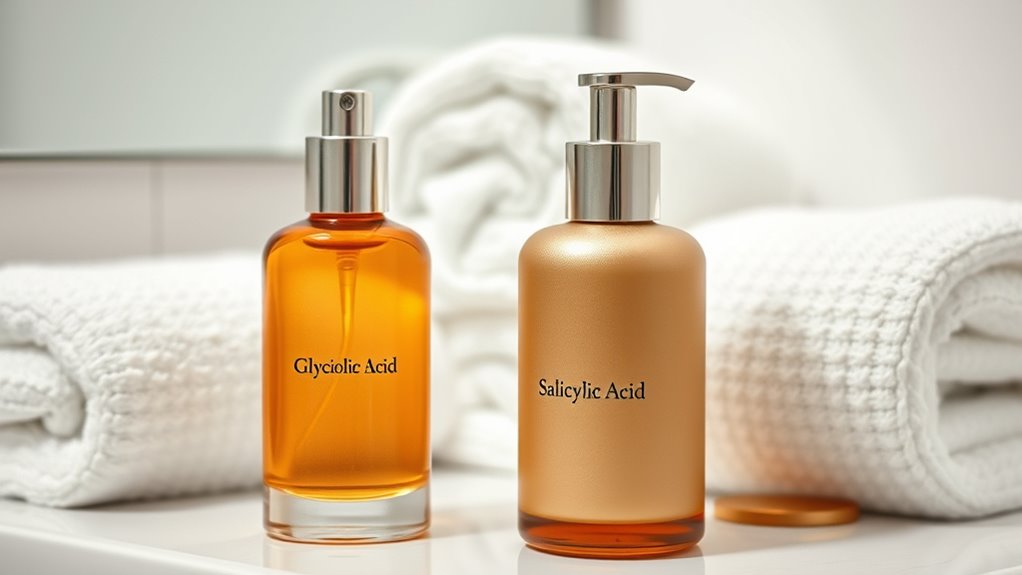
Choosing the right exfoliation products depends on your skin type, concerns, and goals. For gentle exfoliation and improved skin texture, select glycolic acid products with 5-10% concentration. If you’re targeting pore congestion and acne, salicylic acid formulations with 1-2% work well. Sensitive or dry skin benefits from lower concentrations and soothing ingredients like aloe vera or niacinamide. Incorporate glycolic acid serums or toners 2-3 times weekly, while salicylic acid cleansers or spot treatments can be used daily or every other day. Always patch-test and start with lower concentrations. Here’s a quick guide to product selection:
| Skin Type | Best Exfoliant |
|---|---|
| Sensitive | Low-concentration glycolic acid, soothing additives |
| Oily/Acne-prone | Salicylic acid products, daily use |
| Dry | Mild glycolic acid, infrequent use |
| Normal | Both acids, depending on goals |
| Combination | Tailored routine with both acids |
Achieving Radiant Skin With Proper Exfoliant Use

Achieving radiant skin with proper exfoliant use requires a thoughtful approach that prioritizes skin health and gradual adaptation. Start with low concentrations of glycolic acid or salicylic acid, and increase frequency slowly to reduce skin sensitivity and irritation. Incorporate exfoliation into your skincare routines once or twice weekly—more isn’t better. Always apply SPF daily, as acids heighten sun sensitivity and can damage your skin barrier. Use gentle, hydrating products alongside exfoliants to maintain skin barrier integrity and prevent dryness. Monitoring how your skin responds allows you to adjust your routine effectively. Remember, consistent, moderate exfoliation produces brighter, smoother skin over time, making your chemical peel or exfoliation efforts truly worthwhile.
Frequently Asked Questions
Is Glycolic Acid or Salicylic Acid Better for Exfoliating?
When choosing between glycolic acid and salicylic acid for exfoliation, it depends on your skin concerns. If you want to brighten dull skin and reduce fine lines, glycolic acid is your go-to. But if you’re dealing with oily skin and acne, salicylic acid works better by deep-cleaning pores. Consider your skin type and goals, and you’ll find the best exfoliant to suit your needs.
Is Glycolic Acid or Salicylic Acid Better for Unclogging Pores?
You’re wondering which acid truly clears your pores. The answer lies in deep cleansing—salicylic acid dives into pores, dissolving sebum and unclogging stubborn blackheads and whiteheads. Glycolic acid, on the other hand, mostly works on surface exfoliation, leaving pores less targeted. If you want effective pore unclogging, salicylic acid’s your best bet. But for overall skin brightness, glycolic acid still plays a valuable role.
Is It Okay to Use Glycolic Acid and Salicylic Acid Together?
You might wonder if it’s okay to use glycolic acid and salicylic acid together. While it’s possible if your skin tolerates both, it can increase irritation, dryness, or redness. To stay safe, alternate their use—like glycolic one night and salicylic the next—and start with low concentrations. Always patch-test first, and monitor your skin’s response. If irritation persists, consult a dermatologist before combining these acids regularly.
Is Glycolic Acid or Salicylic Acid Better for Feet?
When choosing between glycolic and salicylic acid for your feet, consider your skin concerns. If you want to improve overall texture and smoothness, glycolic acid is your best bet, as it gently exfoliates surface dead skin. However, if you struggle with stubborn calluses, deep cracks, or clogged pores, salicylic acid penetrates further to reduce inflammation and loosen hardened skin effectively. Your choice depends on your specific foot care needs.
Conclusion
Don’t let concerns about irritation hold you back—when used correctly, both acids can give you radiant, smooth skin. Incorporate them gradually and follow product instructions to avoid over-exfoliation. With patience and proper care, you’ll see brighter, clearer skin without the harsh side effects. So go ahead, indulge in this luxurious exfoliation routine—you deserve it! Remember, consistency is key to revealing your best complexion.
